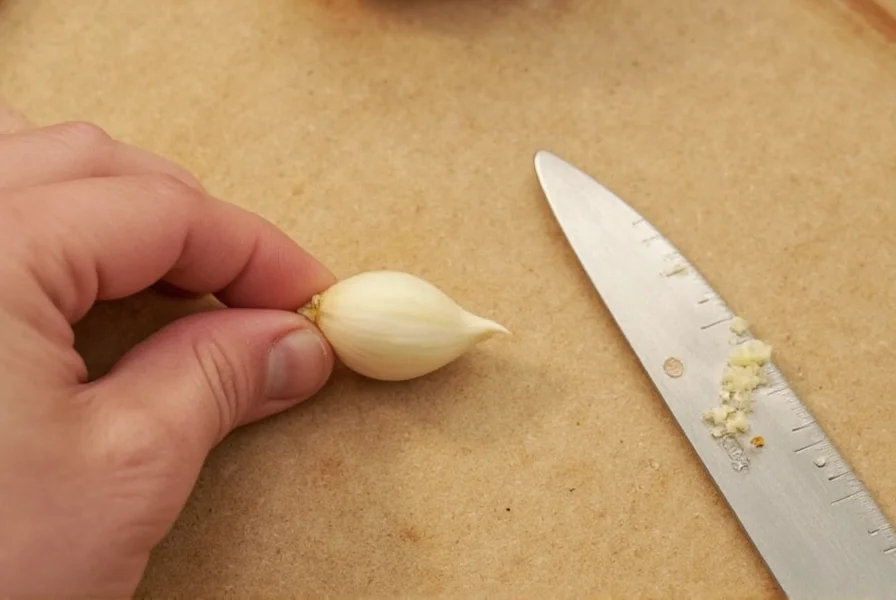Understanding garlic measurements is crucial for home cooks and professional chefs alike. When recipes specify “1 clove of garlic” but you’re working with pre-minced garlic or need to substitute garlic powder, knowing the exact teaspoon equivalent ensures your dishes achieve the perfect flavor balance without overpowering other ingredients.
Garlic Clove to Teaspoon Conversion Guide
The standard conversion assumes a medium-sized garlic clove (about 1 inch long and 3/4 inch in diameter). However, garlic cloves vary significantly in size, which directly impacts the teaspoon measurement:
| Garlic Clove Size | Minced Garlic (Teaspoons) | Garlic Powder (Teaspoons) |
|---|---|---|
| Small (1/2 inch) | 1/4 tsp | 1/8 tsp |
| Medium (1 inch) | 1/2 tsp | 1/4 tsp |
| Large (1 1/4 inches) | 3/4 tsp | 3/8 tsp |
| Jumbo (1 1/2 inches) | 1 tsp | 1/2 tsp |
Factors Affecting Garlic Measurement Accuracy
Several variables influence the precise teaspoon equivalent of a garlic clove:
- Garlic variety - Softneck varieties typically have smaller cloves than hardneck types
- Preparation method - Minced garlic packs differently than roughly chopped
- Moisture content - Freshly harvested garlic contains more water than cured bulbs
- Age of garlic - Older garlic dries out, reducing volume but intensifying flavor
Practical Kitchen Applications
When following recipes, consider these practical applications of the garlic clove to teaspoon conversion:
For Italian tomato sauces requiring 3 cloves of garlic, use 1 1/2 teaspoons of minced garlic. When making garlic bread with 4 cloves, incorporate 2 teaspoons of minced garlic into the butter mixture. In marinades where recipes call for 2 cloves, 1 teaspoon of minced garlic provides equivalent flavor without overwhelming the other ingredients.
Chefs often recommend starting with slightly less garlic than the conversion suggests, then adjusting to taste. Garlic’s potency varies by season and growing conditions, so personal preference should guide final seasoning.
Garlic Substitution Guidelines
When fresh garlic isn’t available, these substitution ratios maintain recipe integrity:
- 1 teaspoon fresh minced garlic = 1/8 teaspoon garlic powder
- 1 teaspoon fresh minced garlic = 1/2 teaspoon garlic paste
- 1 teaspoon fresh minced garlic = 1 teaspoon garlic-infused oil
Remember that dried garlic products deliver more concentrated flavor than fresh. When substituting garlic powder for fresh cloves, use approximately half the volume. For example, if a recipe calls for 1 teaspoon of minced garlic (equivalent to 2 cloves), use only 1/2 teaspoon of garlic powder.
Storage Impact on Garlic Measurements
Garlic’s storage conditions significantly affect both volume and potency. Properly stored garlic (in a cool, dark place with good air circulation) maintains consistent flavor for 3-5 months. As garlic ages and dries out, the same physical volume delivers stronger flavor.
Freshly harvested “wet” garlic contains more moisture, so 1/2 teaspoon might equal a slightly larger clove. Conversely, cured garlic shrinks slightly but intensifies in flavor, meaning the same 1/2 teaspoon measurement delivers more pungency.
Professional Chef Recommendations
Experienced chefs emphasize consistency in garlic preparation. When precision matters, they recommend:
- Using a microplane for the most consistent minced garlic texture
- Measuring after mincing rather than estimating by clove size
- Adding garlic gradually to taste, especially in delicate dishes
- Considering the dish’s cooking time - longer cooking reduces garlic’s sharpness
For international recipes that specify “1 head of garlic,” this typically equals 10-12 cloves or 5-6 tablespoons of minced garlic, though head size varies considerably by garlic variety.
How many teaspoons is 2 cloves of garlic?
Two medium garlic cloves yield approximately 1 teaspoon of minced garlic. For small cloves, use 1/2 teaspoon; for large cloves, use 1 1/2 teaspoons. Always consider the specific recipe requirements and your personal taste preferences when measuring.
Is 1 clove of garlic the same as 1 teaspoon?
No, one medium garlic clove equals approximately 1/2 teaspoon of minced garlic, not a full teaspoon. A jumbo clove (1 1/2 inches long) yields about 1 teaspoon of minced garlic. Using a full teaspoon for a standard clove would result in twice the intended garlic flavor.
How much jarred minced garlic equals one clove?
One medium garlic clove equals approximately 1/2 teaspoon of jarred minced garlic. However, jarred garlic often contains preservatives and may have a slightly different flavor profile than fresh. Start with 1/3 teaspoon and adjust to taste, as jarred garlic can vary in concentration between brands.
Can I substitute garlic powder for fresh cloves?
Yes, use 1/8 teaspoon of garlic powder for each medium garlic clove required. Garlic powder is more concentrated, so the conversion ratio is 1:4 (1 clove fresh = 1/4 tsp powder). For 3 cloves of fresh garlic, use 3/4 teaspoon of garlic powder. Remember that powder lacks the fresh aroma but provides consistent flavor.
Does roasting garlic change the teaspoon measurement?
Roasting concentrates garlic’s flavor but reduces its volume slightly through moisture loss. One roasted medium clove yields about 1/3 teaspoon of paste, with more intense flavor than raw. When substituting roasted for raw garlic, use approximately 25% less by volume to achieve similar flavor intensity in your dish.











 浙公网安备
33010002000092号
浙公网安备
33010002000092号 浙B2-20120091-4
浙B2-20120091-4